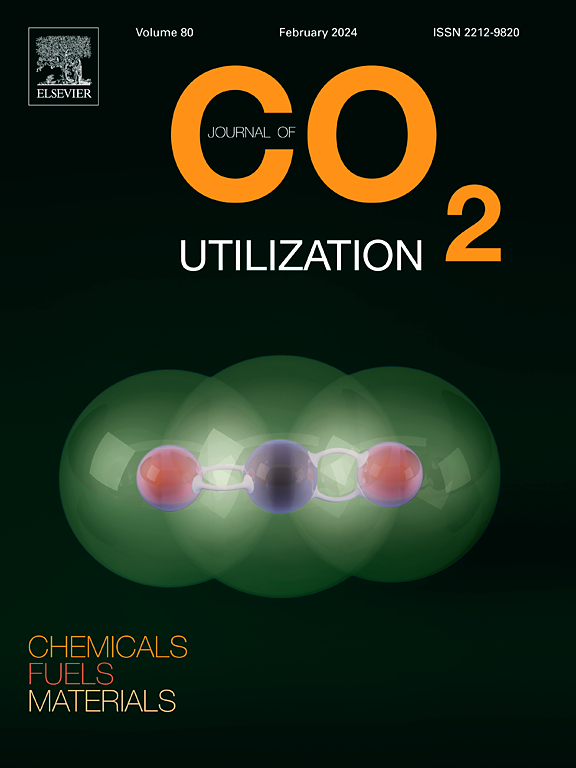在低温费托合成中通过二氧化碳加氢生产净零可持续航空燃料(SAF):工艺设计和替代品
IF 8.4
2区 工程技术
Q1 CHEMISTRY, MULTIDISCIPLINARY
引用次数: 0
摘要
可持续航空燃料(SAF)是航空业脱碳的基础,航空业仍然是最难实现电气化的行业之一。在现有的生产路线中,间接CO₂加氢产生的SAF作为一种有前途的替代方案脱颖而出,提供与现有基础设施兼容的插入式燃料。这项工作提出并比较了从捕获的二氧化碳、绿色氢和可再生电力中生产SAF的三种热自给自足的过程替代方案。基本情况遵循传统配置,包括反水气转换(RWGS)、费托(FT)、加氢裂化装置和自热转化(ATR)反应器。第一种方案是用两个炉代替ATR,用胺吸收装置代替基于psa的CO₂分离。它还包括一个异构化床,以降低SAF的凝固点,一个分隔墙柱(DWC)的有效分离,和一个蒸汽轮机,以回收部分工厂的电力需求。第二种选择保留ATR,同时整合CO₂捕获,异构化床和DWC。分析表明,考虑到电解氢的高成本,维持ATR反应器可以减少氢消耗(第二种替代方案中每公斤产品消耗0.52 kg H₂),在经济上比最小化功耗(第一种替代方案中每吨产品消耗716 kWh)更有利(SAF为3.65欧元/L)。此外,DWC被证明是最有效的分离选择,需要最低的再沸器负荷和最少的托盘。所有工艺配置都会产生水作为唯一的副产品(约3.3 kg H₂O/kg产品),并实现每公斤产品高达- 2 kg CO₂eq的净负温室气体排放。本文章由计算机程序翻译,如有差异,请以英文原文为准。
Net-zero sustainable aviation fuel (SAF) production via CO2 hydrogenation in low-temperature Fischer-Tropsch synthesis: Process design and alternatives
Sustainable Aviation Fuel (SAF) is fundamental for decarbonizing the aviation sector, which remains one of the hardest industries to electrify. Among the available production routes, SAF derived from indirect CO₂ hydrogenation stands out as a promising alternative, delivering drop-in fuels compatible with existing infrastructure. This work presents and compares three thermally self-sufficient process alternatives for SAF production from captured CO₂, green hydrogen, and renewable electricity. The base case follows a conventional configuration consisting of Reverse Water Gas Shift (RWGS), Fischer-Tropsch (FT), hydrocracker, and Auto-Thermal Reformer (ATR) reactors. The first alternative replaces the ATR with two furnaces and substitutes the PSA-based CO₂ separation with an amine absorption unit. It also includes an isomerization bed to reduce SAF’s freezing point, a Dividing Wall Column (DWC) for efficient separation, and a steam turbine to recover part of the plant’s power demand. The second alternative retains the ATR while integrating CO₂ capture, the isomerization bed, and the DWC. The analysis shows that maintaining the ATR reactor reduces hydrogen consumption (0.52 kg H₂ per kg of products in the second alternative), being economically more favorable (3.65 €/L of SAF) than minimizing power consumption (716 kWh per ton of products in the first alternative), given the high cost of electrolytic hydrogen. In addition, the DWC proves to be the most efficient separation option, requiring the lowest reboiler duty and the fewest trays. All process configurations produce water as the only byproduct (approximately 3.3 kg H₂O/kg products), and achieve net-negative greenhouse gas emissions of up to −2 kg CO₂eq per kg of product.
求助全文
通过发布文献求助,成功后即可免费获取论文全文。
去求助
来源期刊

Journal of CO2 Utilization
CHEMISTRY, MULTIDISCIPLINARY-ENGINEERING, CHEMICAL
CiteScore
13.90
自引率
10.40%
发文量
406
审稿时长
2.8 months
期刊介绍:
The Journal of CO2 Utilization offers a single, multi-disciplinary, scholarly platform for the exchange of novel research in the field of CO2 re-use for scientists and engineers in chemicals, fuels and materials.
The emphasis is on the dissemination of leading-edge research from basic science to the development of new processes, technologies and applications.
The Journal of CO2 Utilization publishes original peer-reviewed research papers, reviews, and short communications, including experimental and theoretical work, and analytical models and simulations.
 求助内容:
求助内容: 应助结果提醒方式:
应助结果提醒方式:


